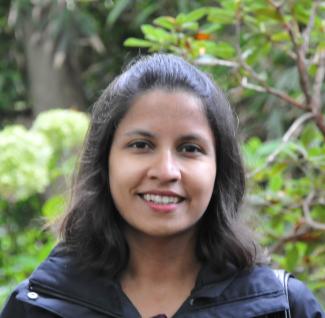Event
Physical Chemistry Seminar: Dr. Shaama Sharada, USC
"Catalyst discovery for metal-free, photoredox CO2 reduction"

POSTPONED
TBD
Abstract
-Organic photoredox catalysis will be an important part of an energy-efficient, sustainable future as these catalysts can access highly reactive states upon excitation and quenching to carry out reactions that are otherwise thermally inaccessible or energy-intensive. Our group aims to identify sustainable photoredox routes for CO2 utilization. Prior experiments show that a simple organic chromophore, p-terphenyl, can reduce and transform CO2 into useful molecules such as amino acids. However, the steps of the photoredox cycle and reasons for low turnover numbers of these catalysts are poorly understood. Our goal is to utilize quantum chemistry methods to delineate mechanisms of key steps in this cycle and leverage these insights to drive discovery of novel chromophores that are both active and yield high turnover numbers. Thus far, we have demonstrated that the electron transfer (ET) step from the p-terphenyl radical anion to CO2 is adiabatic, and ET barriers are lowered when electron-donating groups are substituted to p- terminal positions of the catalyst. To probe degradation pathways from the excited state, we are establishing a protocol for calculation and characterization of excited-state donor-acceptor charge transfer complexes in collaboration with the Dawlaty group at USC. We are also taking our first steps towards driving discovery of new chromophores by implementing a genetic algorithm (GA) whose fitness function factors in both catalyst activity and degradation resistance by means of simple descriptors obtained from routine DFT calculations. The GA yields several candidates that are more viable than experimentally studied terphenyls, highlighting the importance of automated computational tools in accelerating experimental efforts.
Research
Research focuses on developing catalysts and photocatalysts to meet energy-efficiency and sustainability goals. Her group utilizes quantum chemistry to find active, selective, and stable catalytic materials for efficient valorization of CH bonds and green conversion of anthropogenic carbon dioxide. Shaama is also keen on making quantum chemical predictions more reliable. She is developing algorithms inspired from signal processing to make otherwise prohibitive but accurate kinetics theories more tractable for routine studies.
Bio
Dr. Shaama Mallikarjun Sharada is an Assistant Professor in the Mork Family Department of Chemical Engineering and Materials Science and in the Department of Chemistry (by Courtesy) at the University of Southern California. Her research interests span the development and application of quantum chemistry methods to design catalysts for sustainable chemistry transformations. Her group is developing efficient algorithms, inspired from signal processing, for advancing sophisticated rate theories in catalysis. The group is also establishing frameworks for catalyst design and discovery towards efficient natural gas conversion and light-assisted carbon dioxide utilization. Dr. Sharada received her Bachelors and Masters in Chemical Engineering from the Indian Institute of Technology, Bombay (India) where she was awarded the Institute Gold Medal. She received her PhD in Chemical Engineering from UC Berkeley in 2015 for developing efficient reaction path search algorithms for catalysis. As a postdoctoral researcher at Stanford University, her work spanned the development of machine learning density functionals and surface chemistry benchmarking databases. She is a recipient of the 2022 inaugural Chevron Research Innovation Award (USC) and the 2020 ACS Petroleum Research Fund Doctoral New Investigator Award. She is also a Scialog Fellow for the Negative Emissions Science initiative.
https://sharada-lab.usc.edu
HOST: SUBOTNIK
